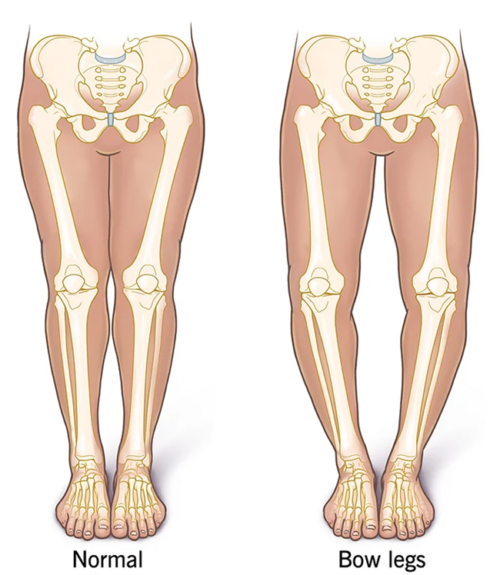Bow Legs
Bow Legs are common in Infants and Toddlers
Bow legs (genu varum) is a condition where one or both of your child’s legs curve outward at the knees. This creates a wider space than normal between the knees and lower legs. When your child stands with his or her feet and ankles together, the knees stay wide apart. Your child’s legs may look like a bow, especially when they walk.

Symptoms of Bow Legs:
The main sign of bowed legs is the appearance of your child’s legs. Their knees won’t touch when they stand with their feet and ankles together. The bowing is most obvious when they’re walking. Sometimes children may walk with their toes pointed inward (pigeon toes or intoeing).
However, bow legs usually don’t cause any pain. Bow legs don’t affect your child’s ability to crawl, walk or run. If your child’s bow legs don’t start to improve by age 2, contact your child’s healthcare provider.
Causes of Bow Legs:
Bow legs develop for a number of different reasons. The most common cause of bow legs is a condition called physiologic genu varum. When the fetus was developing in your uterus, it was in a cramped position. Some of the fetal bones had to rotate while they were in your uterus so they could fit in the small space.
Physiologic genu varum is just your child going through the normal developmental process. If your child’s legs haven’t straightened by 2 years old, there may be another reason. These include:
- Blount’s disease. Blount’s disease (tibia vara) is a growth disorder caused by an issue in the growth plate of your child’s shin bone. Blount’s disease is more common in African American children, children who are overweight and children who walked early.
- Rickets. Rickets is caused by a calcium or vitamin D deficiency. Deficiencies in these important nutrients make your child’s bones softer and weaker, causing his or her legs to bow. Rickets is very rare in the United States but still occurs often in developing countries.
- Dwarfism. The most common type of dwarfism is caused by a bone growth disorder called achondroplasia. This disorder can cause bow legs.
- Other bone issues. Fractures that haven’t healed correctly and abnormally developed bones (bone dysplasia) can cause bow legs.
- Fluoride or lead poisoning.
Diagnosis:
Shreya Hopspital at Ghaziabad is the best diagnosis and treatment center for Bow Legs. Orthopedic Specialists at Shreya Hospital have expertise in diagnosing your child’s Bow Legs issue.
They will do a physical exam and ask about your child’s medical history. But if your child is under 2 years old, no further tests required. Rather, they’ll want to watch the bowing and make sure it resolves on its own as your child grows.
If your child is older than 2, Doctor may measure your child’s legs and watch him or her walk. They may order imaging tests such as X-rays to view the bones in your child’s legs and knees. They may order blood tests to determine whether the bow legs are being caused by a condition such rickets.
Treatment:
No treatment is necessary in babies and toddlers unless the condition is severe. If bow legs continue after age 2, treatment depends on the cause of the condition. Treatment may include special shoes, splints, braces, casts, surgery or treatment of the condition causing the bow legs.
- Blount’s disease. Early treatment with a splint or leg brace may be all that’s needed.
- Rickets. Your child’s healthcare provider may treat your child’s condition by adding vitamin D and calcium to their diet. Your child’s healthcare provider may refer you to a specialist for treatment if the rickets is due to a genetic condition.
If bowing continues despite other treatments, surgery may be needed to prevent further damage and correct the issue. Surgery options include:
- Guided growth. With this procedure, your child’s surgeon will place a small metal plate or staple in your child’s leg. This will temporarily stop growth on the healthy side of the shin bone so the unhealthy side can catch up. Your child’s leg will straighten with their natural growth, and your child’s surgeon will remove the plate or staple once alignment has improved.
- Tibial osteotomy. With this procedure, your child’s surgeon cuts the shin bone below the knee and reshapes it to fix the alignment. While the bone heals, it’s held in place with a plate and screws inside the leg or a frame that’s positioned outside the leg.
 Dr Dev Mishra Best Orthopaedic Doctor in Delhi NCR Ghaziabad
Dr Dev Mishra Best Orthopaedic Doctor in Delhi NCR Ghaziabad
